Reminiscing
 There is a wall that lots o people might have known about, or maybe few people know about, but while I’m sure I’ve seen parts of it in movies, I didn’t really know about it. The series of walls, known as the East Bay Walls or the Berkeley Mystery Walls. Of course that doesn’t really apply to one area, because the reality is that there are many of the crude walls throughout the hills surrounding the San Francisco Bay area. In some place the walls are as much as 3 feet tall, and 3 feet wide. The walls are very old and they were built without mortar. The walls run in sections, and they can be a few feet to over a mile long. Even more odd, is the fact that the rocks are a variety of sizes ranging from basketball-sized rocks, to large sandstone boulders weighing a ton or more. Parts of the walls seem to be just piles of rocks, but in other places it appears the walls were carefully constructed. No one knows the exact age of the walls, but they have an old appearance. Many of the formations have sunk far into the earth, and are often completely overgrown with different plants. The walls are not continuous, so they are not fences. They are not tall enough to have been used as defensive walls. The East Bay Regional Park District simply calls them “rock walls” and insists that they are not mysterious. Livestock, such as cattle, have grazed in the east and south Bay Area hills since the arrival of European
There is a wall that lots o people might have known about, or maybe few people know about, but while I’m sure I’ve seen parts of it in movies, I didn’t really know about it. The series of walls, known as the East Bay Walls or the Berkeley Mystery Walls. Of course that doesn’t really apply to one area, because the reality is that there are many of the crude walls throughout the hills surrounding the San Francisco Bay area. In some place the walls are as much as 3 feet tall, and 3 feet wide. The walls are very old and they were built without mortar. The walls run in sections, and they can be a few feet to over a mile long. Even more odd, is the fact that the rocks are a variety of sizes ranging from basketball-sized rocks, to large sandstone boulders weighing a ton or more. Parts of the walls seem to be just piles of rocks, but in other places it appears the walls were carefully constructed. No one knows the exact age of the walls, but they have an old appearance. Many of the formations have sunk far into the earth, and are often completely overgrown with different plants. The walls are not continuous, so they are not fences. They are not tall enough to have been used as defensive walls. The East Bay Regional Park District simply calls them “rock walls” and insists that they are not mysterious. Livestock, such as cattle, have grazed in the east and south Bay Area hills since the arrival of European 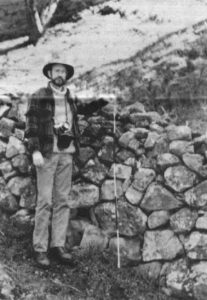 settlers. Clearing land of scattered rocks would have eased the ability to move livestock. Placing the rocks into walls would have helped to guide the movement of the animals or to help corral them. That makes sense, but some of those rocks were very heavy. So how did they do that.
settlers. Clearing land of scattered rocks would have eased the ability to move livestock. Placing the rocks into walls would have helped to guide the movement of the animals or to help corral them. That makes sense, but some of those rocks were very heavy. So how did they do that.
There is no written documentation to identify when they were built, by whom, or why. So, some people consider them mysterious. It has been suggested that the Ohlone Indians might have been the builders, but in reality, they were hunter-gatherers, and didn’t build permanent structures. Some specialists have mentioned that the walls look similar to structures found in rural Massachusetts, Vermont, and Maine, but they are different in that those walls were built around farms by the early setters, and these don’t have the same kinds of layouts. In 1904, UC-Berkeley Professor John Fryer suggested that the walls were made by Mongolian Chinese who traveled to California before the Europeans. Unfortunately, there is little evidence for this or for pre-Columbian Chinese influence in America. Forensic geologist Scott Wolter has theorized that the wall is only two to three hundred years old, suggested by the thick weathering rind on the limestone rock he was authorized to sample. Recent testing of lichen on the rocks suggests that they were probably built between 1850 and 1880, the early American era in California. Settlers might have built the walls using Chinese, Mexican, or Native American laborers, although specifically who built them has not been determined.
One of the many old stone walls that appear around the San Francisco Bay area is in the foothills of eastern 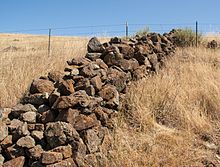 Santa Clara County. The stone walls are accessible in several area parks, including Ed R. Levin County Park in Santa Clara County and Mission Peak Regional Preserve in Alameda County, as well as many other parks. As of 2016, archaeologist Jeffrey Fentress has been measuring and mapping the walls, hoping to eventually gain protection from development or other destruction. Additional stone walls with unclear origin or purpose occur in other places near the San Francisco Bay, and researchers continue to discover more information about the walls. Whether these walls had a purpose at one time or not, they are certainly strange to those who try to look into them these days.
Santa Clara County. The stone walls are accessible in several area parks, including Ed R. Levin County Park in Santa Clara County and Mission Peak Regional Preserve in Alameda County, as well as many other parks. As of 2016, archaeologist Jeffrey Fentress has been measuring and mapping the walls, hoping to eventually gain protection from development or other destruction. Additional stone walls with unclear origin or purpose occur in other places near the San Francisco Bay, and researchers continue to discover more information about the walls. Whether these walls had a purpose at one time or not, they are certainly strange to those who try to look into them these days.
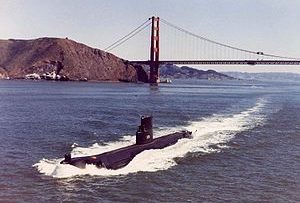 Submarines have always fascinated me. To be able to travel completely submerged for extended periods of time is quite amazing. One of the greatest submarines ever was the USS Seawolf (SSN 575). Seawolf was not the first nuclear submarine. That honor goes to the Nautilus, but the Seawolf was an amazing submarine with an amazing future ahead of her. The Seawolf was built by the General Dynamics Corporation’s Electric Boat Division, Groton, Connecticut, and was laid September 15, 1953. Mrs. W. Sterling Cole christened the SEAWOLF at the launching ceremony on July 21, 1955 under the command of Commander Richard B. Laning, United States Navy.
Submarines have always fascinated me. To be able to travel completely submerged for extended periods of time is quite amazing. One of the greatest submarines ever was the USS Seawolf (SSN 575). Seawolf was not the first nuclear submarine. That honor goes to the Nautilus, but the Seawolf was an amazing submarine with an amazing future ahead of her. The Seawolf was built by the General Dynamics Corporation’s Electric Boat Division, Groton, Connecticut, and was laid September 15, 1953. Mrs. W. Sterling Cole christened the SEAWOLF at the launching ceremony on July 21, 1955 under the command of Commander Richard B. Laning, United States Navy.
Unlike, Nautilus, the Seawolf used liquid sodium instead of water as a moderator and cooling medium. The Seawolf was to be given many honors and awards during her time of service, with one of the greatest being on September 26, 1957, when Seawolf hosted President Dwight D. 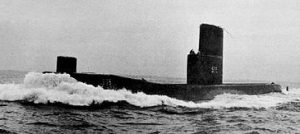 Eisenhower for a submerged run off Newport, Rhode Island. It was the first time the Commander and Chief was transported by nuclear propulsion. That makes it an amazing event for the Seawolf and for the President. Additionally, while on a port visit in Provincetown, Massachusetts, Seawolf was host to NBC telecast of “Wide, Wide World” on December 8, 1957.
Eisenhower for a submerged run off Newport, Rhode Island. It was the first time the Commander and Chief was transported by nuclear propulsion. That makes it an amazing event for the Seawolf and for the President. Additionally, while on a port visit in Provincetown, Massachusetts, Seawolf was host to NBC telecast of “Wide, Wide World” on December 8, 1957.
One of the greatest moments, however, happened on October 6, 1958. After submerging on August 7, 1958, Seawolf remained submerged for a full 60 days. During that time she was completely independent of the Earth’s atmosphere. The submarine was self sufficient and able to produce all the life sustaining air and water the crew would need for life. It was an unheard of accomplishment. Of course, that record would be broken in  the future, including twice by Seawolf herself. In 1976, Seawolf remained submerged for a US Navy record breaking 87 days. In 1977 she again went under, this time staying submerged for 79 days. Over the years of service, Seawolf received four Battle Efficiency “E” awards for excellence in battle. She received three Engineering “E” for Excellence, three Supply “E” awards, a Communications “C” award, a Damage Control “DC” award, and the Dec Seamanship Award. In April 1986 USS Seawolf (SSN 575) was decommissioned, but her name has lived on in other submarines named in her honor. The USS Seawolf (SSN 575) was truly an amazing submarine.
the future, including twice by Seawolf herself. In 1976, Seawolf remained submerged for a US Navy record breaking 87 days. In 1977 she again went under, this time staying submerged for 79 days. Over the years of service, Seawolf received four Battle Efficiency “E” awards for excellence in battle. She received three Engineering “E” for Excellence, three Supply “E” awards, a Communications “C” award, a Damage Control “DC” award, and the Dec Seamanship Award. In April 1986 USS Seawolf (SSN 575) was decommissioned, but her name has lived on in other submarines named in her honor. The USS Seawolf (SSN 575) was truly an amazing submarine.
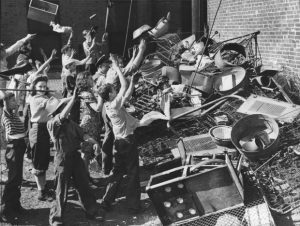 When the United States was pulled into World War II following the Japanese attack on Pearl Harbor. raw materials were in high demand globally, and hard to come by. Commodities such as rubber and cloth became precious and very valuable to the war effort. Many of the men were now off fighting the war, and so the factories, mines, etc. were not producing the necessary materials to build the much needed military equipment and weapons for the war effort.
When the United States was pulled into World War II following the Japanese attack on Pearl Harbor. raw materials were in high demand globally, and hard to come by. Commodities such as rubber and cloth became precious and very valuable to the war effort. Many of the men were now off fighting the war, and so the factories, mines, etc. were not producing the necessary materials to build the much needed military equipment and weapons for the war effort.
When it was decided that the country needed a drive to supply these materials, the Community-Minded Patriotism of the United States Home Front swung into action. The nation decided that they needed a drive to collect the materials needed. On Oct. 5, 1942, the first day of the first drive, young people throughout the city and county hauled in 2,800 tons of scrap metal to feed industry during World War II. By Oct. 16, the end of the campaign, their total was 7,658 tons, which is the combined weight of 230 Sherman tanks.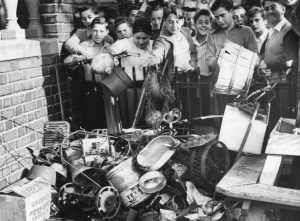
More scrap drives were organized across the country, encouraging citizens to contribute their rubber to make jeep tires, their clothing to make cleaning rags, their nylon and silk stockings to make parachutes, and their leftover cooking fat to make explosives. One of the most vital materials to collect was scrap metal. A single medium tank required 18 tons of it, and a single Navy ship hundreds more. For many people, I’m sure it looked like a great way to get rid of all those items most of us would try to unload at a garage sale.
The scrap metal drives became very competitive, almost frenzied affairs, as communities fought to out-contribute each other. Housewives threw in their aluminum pots and pans, farmers sacrificed their old tractors, and cities and towns ripped up wrought iron fences, trolley tracks and historic Civil War cannons. People were encouraged to imagine their household items being transformed into armor and weaponry for their soldiers and 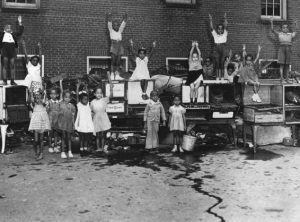 sailors in harm’s way. It was a great way to energize the Home Front. In Lubbock, Texas, a bust of Hitler was erected as a target for patriotic citizens to hurl their cookware. It was a way to take out their anger a little bit, and it worked. Walt Disney donated two iron Bambi sculptures, which were said to contain enough iron for 10,000 incendiary bombs or one 75 millimeter artillery piece. In all reality, the effect of these scrap metal drives on actual war production was very small, marginal at best. Nevertheless, their true value was in galvanizing citizen morale and a sense of patriotic unity…making everyone like they took part in the war effort. So, in the end, the scrap days did their job very well.
sailors in harm’s way. It was a great way to energize the Home Front. In Lubbock, Texas, a bust of Hitler was erected as a target for patriotic citizens to hurl their cookware. It was a way to take out their anger a little bit, and it worked. Walt Disney donated two iron Bambi sculptures, which were said to contain enough iron for 10,000 incendiary bombs or one 75 millimeter artillery piece. In all reality, the effect of these scrap metal drives on actual war production was very small, marginal at best. Nevertheless, their true value was in galvanizing citizen morale and a sense of patriotic unity…making everyone like they took part in the war effort. So, in the end, the scrap days did their job very well.
 The Nazi bombers were notorious for their sneaky bomber raid, especially the night bombings. The British decided that it was time for start fighting back. So they came up with the idea of using German speaking individuals to impersonate German air controllers, broadcasting false orders to confuse German fighter pilots. The plan was called Operation Corona, and the scope of the operation was massive, but ironically, it was only made possible because of German-speaking Jewish refugees who had escaped Germany and settled in Britain. What an amazing way for the Jewish refugees to be able to get back at the Nazis for the horrid treatment they had received and that they had escaped thankfully. Now, these refugees were breaking into Luftwaffe radio channels and playing wreaking havoc on the Luftwaffe’s ability to direct their night fighters.
The Nazi bombers were notorious for their sneaky bomber raid, especially the night bombings. The British decided that it was time for start fighting back. So they came up with the idea of using German speaking individuals to impersonate German air controllers, broadcasting false orders to confuse German fighter pilots. The plan was called Operation Corona, and the scope of the operation was massive, but ironically, it was only made possible because of German-speaking Jewish refugees who had escaped Germany and settled in Britain. What an amazing way for the Jewish refugees to be able to get back at the Nazis for the horrid treatment they had received and that they had escaped thankfully. Now, these refugees were breaking into Luftwaffe radio channels and playing wreaking havoc on the Luftwaffe’s ability to direct their night fighters.
On one night in 1943, the British managed to get almost all the German night fighters to fly home, and only one aircraft was lost during that night. Another night, a German night fighter, who was already lost, was redirected to a British airfield and captured. I can’t imagine what was going on in the minds of the commanding officers in charge of the night fighters. Their men were presumably, totally mixed up, and every mission failed to bring the desired result.
For me, the most amazing part has to do with the Jewish involvement. Hitler was so intent on killing the Jewish 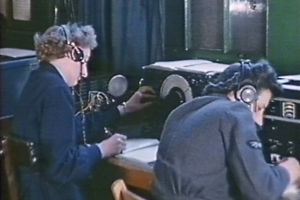 people, and in this instance, it was a group of Jewish people who were able to pull of a great victory over Hitler and his night fighter pilots. Operation Corona was made possible because before the war many people, mostly Jews, fled Nazi Germany to England, and I seriously doubt if Hitler ever knew what happened, but those people who were involved knew, and while they were not able to help their own people directly, I’m sure it gave them some satisfaction to know that they were doing their part to fight against the horrible dictator who was responsible for the deaths of so many of their people. Operation Corona gave them the opportunity they needed to do something big to help in ending the war and bringing victory to the Allies, thereby helping many of their own people too.
people, and in this instance, it was a group of Jewish people who were able to pull of a great victory over Hitler and his night fighter pilots. Operation Corona was made possible because before the war many people, mostly Jews, fled Nazi Germany to England, and I seriously doubt if Hitler ever knew what happened, but those people who were involved knew, and while they were not able to help their own people directly, I’m sure it gave them some satisfaction to know that they were doing their part to fight against the horrible dictator who was responsible for the deaths of so many of their people. Operation Corona gave them the opportunity they needed to do something big to help in ending the war and bringing victory to the Allies, thereby helping many of their own people too.

 As I was thinking about today, I found that today is actually a special day…Look at the Leaves Day. Now, if you are like me, you have likely never heard of Look at the Leaves Day, or if you have, you might have wondered if it was a day that was inspired by a science teacher, or something. And, maybe it was in the beginning, but this time of year, the leaves truly are something interesting, especially if you live in an area where there is a variety of fall colors in the leaves. I live in an area where the leaves mostly have two colors…green and yellow, unless you count brown as a pretty fall color…which I don’t.
As I was thinking about today, I found that today is actually a special day…Look at the Leaves Day. Now, if you are like me, you have likely never heard of Look at the Leaves Day, or if you have, you might have wondered if it was a day that was inspired by a science teacher, or something. And, maybe it was in the beginning, but this time of year, the leaves truly are something interesting, especially if you live in an area where there is a variety of fall colors in the leaves. I live in an area where the leaves mostly have two colors…green and yellow, unless you count brown as a pretty fall color…which I don’t.
Nevertheless, looking at the leaves always has a mesmerizing effect on us. I love watching the leaves as they flutter to the ground. The color doesn’t matter at that point. They just look so peaceful on their journey. It is a part of their life cycle. It’s what they do. Grow and flourish, and then in Autumn, they fade and and fall to the ground. They’re all gone by winter, and the trees spend the rest of the Winter looking like skeletons, while they wait for spring when they get their new leaves.
As my husband and I went for a walk tonight, I found myself taking that extra moment to actually look at the leaves. It’s not that I never looked at them before, but today felt…different somehow. I noticed how one tree could be green, and the one next to it yellow. Some trees were half green and half yellow. The few trees and bushes we have in this area that turn red, added a flame-like flair to the look. When I took the time to really look at them, I began to notice how very beautiful they were. I thought about other walks we had taken in the fall. Some of my favorites are on some of the trails in the Black Hills. When you are walking through the trees 
 on a dirt trail, with the leaves dropping all around you, you really feel like you can embrace the season.
on a dirt trail, with the leaves dropping all around you, you really feel like you can embrace the season.
Today was Look at the Leaves Day. It is a day for us to stop rushing around, busy with our hurried lives, and maybe take a few minutes to see the splendor of Autumn for a change. I’m seriously not a winter person, but Autumn is definitely a season that I enjoy. It’s sheer beauty captivates me…for a while, until Autumn gives way, and its ugly sister season…Winter enters in…and I want to be the one to hibernate.
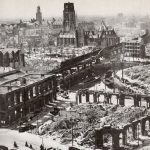 After World War II, most of Europe was in a big mess, whether it was the land,the cities and towns, or the government. There were scores of dead people around, countries and borders were torn apart, most of Europe had been “ground into a very civilized kind of pudding…and the USSR was knocking on the door to come and raid the fridge…so to speak.” Russia would have loved to sneak in and take over when they were at their most vulnerable. The people looked to the United States to figure out away to keep them safe, but not to occupy their countries, per se. That is a rather tall order, but one that the United States took seriously.
After World War II, most of Europe was in a big mess, whether it was the land,the cities and towns, or the government. There were scores of dead people around, countries and borders were torn apart, most of Europe had been “ground into a very civilized kind of pudding…and the USSR was knocking on the door to come and raid the fridge…so to speak.” Russia would have loved to sneak in and take over when they were at their most vulnerable. The people looked to the United States to figure out away to keep them safe, but not to occupy their countries, per se. That is a rather tall order, but one that the United States took seriously.
So the United States came up with Operation Gladio. Basically, they installed a secret military that would unofficially operate all across Europe. The secret military would have one and only one goal…combating communism. Little is known about this secret military, even today, because it wouldn’t be a very good secret army if we knew all about them. So, facts are pretty limited, but it’s not some crazy theory either. Their existence has been confirmed, and the network has been associated with such high-stakes super-evil events, as an attempted pope assassination, large scale bombings, and kidnappings of several high-level government officials. They were willing to do anything to fight communism…murder, extortion, even seemingly becoming communists, if that’s what it took. It turns out that the Italian branch was a particularly active group. An entirely different president of Italy, Francesco Cossiga, was involved in this ominous anti-communism secret society. The reason we don’t know more about them, even years after the end of the Cold War, is simple: crazy, crazy murders. Their secrets will follow them to the grave.
Then a new Italian president was elected. President Aldo Moro, wanted to allow communists to run for office.The still operating Gladio could not let this happen. He was suddenly kidnapped and eventually executed.  His body was found in the trunk of a car parked next to an ancient gladiatorial site. A warning to others…more than probably!! A “gladio” is an ancient Roman short sword, used in arena combat. A former colonel of Gladio operations in Switzerland decided to write a letter to the government stating that he was ready to “reveal the whole truth.” Again, Operation Gladio took action. The Gladio colonel was found dead in his home a month later. He was stabbed to death with his own bayonet. There were a series of mysterious characters written on his chest that couldn’t be deciphered. Of course, that’s not concrete evidence of Gladio’s direct involvement in these events, but these are just two brutal, worrying events that spin a web of mystery and fear that keeps further investigations from being opened. Sometimes, it’s best to let sleeping dogs lie.
His body was found in the trunk of a car parked next to an ancient gladiatorial site. A warning to others…more than probably!! A “gladio” is an ancient Roman short sword, used in arena combat. A former colonel of Gladio operations in Switzerland decided to write a letter to the government stating that he was ready to “reveal the whole truth.” Again, Operation Gladio took action. The Gladio colonel was found dead in his home a month later. He was stabbed to death with his own bayonet. There were a series of mysterious characters written on his chest that couldn’t be deciphered. Of course, that’s not concrete evidence of Gladio’s direct involvement in these events, but these are just two brutal, worrying events that spin a web of mystery and fear that keeps further investigations from being opened. Sometimes, it’s best to let sleeping dogs lie.
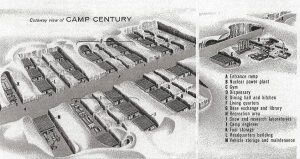 When I think about secrets, nothing very sinister comes to my mind, but when it comes to national or world secrets, maybe we should think a little differently. Of course, not every world or national secret is sinister, but some can be pretty odd. I don’t claim to be privy to any current national security secrets, but I’m finding out some from the past. There were some secrets that most people don’t know about, and some that almost seemed like science fiction. In 1959, the United States used to have a small underground city in the North Pole called Camp Century. It looked a lot like the rebel base on Hoth, which is the sixth planet in the remote system of the same name, and was the site of the Rebel Alliance’s Echo Base, as Star Wars fans would already know. Hoth is a world of snow and ice, surrounded by numerous moons, and home to deadly creatures like the Wampanoag…a cross between a polar bear and a Sasquatch, in looks anyway. Of course, that isn’t what Camp Century really was.
When I think about secrets, nothing very sinister comes to my mind, but when it comes to national or world secrets, maybe we should think a little differently. Of course, not every world or national secret is sinister, but some can be pretty odd. I don’t claim to be privy to any current national security secrets, but I’m finding out some from the past. There were some secrets that most people don’t know about, and some that almost seemed like science fiction. In 1959, the United States used to have a small underground city in the North Pole called Camp Century. It looked a lot like the rebel base on Hoth, which is the sixth planet in the remote system of the same name, and was the site of the Rebel Alliance’s Echo Base, as Star Wars fans would already know. Hoth is a world of snow and ice, surrounded by numerous moons, and home to deadly creatures like the Wampanoag…a cross between a polar bear and a Sasquatch, in looks anyway. Of course, that isn’t what Camp Century really was.
When Camp Century began its life, it was as a scientific outpost located hundreds of feet beneath a Greenland iceberg. From the surface, it looked like nothing more than an ominous snow-covered pyramid. But below, it was gigantic. The base was powered by an underground nuclear reactor, and at one point, is said to have housed a staff of 200. It was a self-contained city, complete with a gym, a chapel, a library, hobby shops and  even a movie theater. I wonder what kinds of movies they watched…movies about the outside world, and in summer no doubt. The plan was for scientific experiments to be conducted there, but as sometimes happens, the military decided it could be better used as a base for their own experiments…namely blowing things up. I suppose they assumed that there was little chance of anyone getting hurt, because of the remoteness of the base. The best kept secrets exist here, and I don’t think I have a big problem with that. So, to recap: The United States had a 200-person nuclear-powered outpost located beneath the ice of the North Pole, where one of their primary objectives was to drill as deep into the unforgiving, ancient ice as possible. Now, that sounds scary.
even a movie theater. I wonder what kinds of movies they watched…movies about the outside world, and in summer no doubt. The plan was for scientific experiments to be conducted there, but as sometimes happens, the military decided it could be better used as a base for their own experiments…namely blowing things up. I suppose they assumed that there was little chance of anyone getting hurt, because of the remoteness of the base. The best kept secrets exist here, and I don’t think I have a big problem with that. So, to recap: The United States had a 200-person nuclear-powered outpost located beneath the ice of the North Pole, where one of their primary objectives was to drill as deep into the unforgiving, ancient ice as possible. Now, that sounds scary.
The military took over in about 1960 and converted Camp Century into a giant ice-bound missile silo. Called Project Iceworm, the goal was to store approximately 600 nuclear missiles in the base, giving the United States a nice, secret little nuclear facility right next to Soviet Russia. Luckily for Russia, technical problems led to the whole mission being scrapped, because maintaining the tunnels was a constant chore. Every month, 120 tons of ice had to be removed to maintain the tunnels. The whole site collapsed within the that decade. Apparently, they worked harder at keeping the tunnels cleared, than at any experiment, or missile setup that they did.
The unites States Department of Defense told the Danish government that the “official purpose” of Camp Century was to test various construction techniques under Arctic conditions, explore practical problems with a semi-mobile nuclear reactor, as well as supporting scientific experiments on the  icecap. The process involved cutting a total of 21 trenches and covering them with arched roofs, within which prefabricated buildings were erected. With a total length of 1.9 mi, these tunnels contained a basically a small town, the total population of which was around 200. From 1960 until 1963 the electricity supply was provided by means of the world’s first mobile/portable nuclear reactor, designated PM-2A and designed by Alco for the United States Army. Water was supplied by melting glaciers and tested to determine whether germs such as the plague were present. Once it was cleared, they were able to use it. Nevertheless, fraught with trouble from the start, it proved a better idea to close it down.
icecap. The process involved cutting a total of 21 trenches and covering them with arched roofs, within which prefabricated buildings were erected. With a total length of 1.9 mi, these tunnels contained a basically a small town, the total population of which was around 200. From 1960 until 1963 the electricity supply was provided by means of the world’s first mobile/portable nuclear reactor, designated PM-2A and designed by Alco for the United States Army. Water was supplied by melting glaciers and tested to determine whether germs such as the plague were present. Once it was cleared, they were able to use it. Nevertheless, fraught with trouble from the start, it proved a better idea to close it down.
 After the August 18, 1976 ace murder of two United States Army officers, Captain Arthur Bonifas and Lieutenant Mark Barrett, by North Korean soldiers, in the Joint Security Area located in the North Korean Demilitarized Zone, it was decided that something had to be done about a certain poplar tree that blocked the view of UN observers, allowing them to be assaulted and killed by the North Koreans, who claimed that the tree had been planted by Kim Il-Sung. It was dubbed the Panmunjom axe murder incident, and it was infuriating to the United States.
After the August 18, 1976 ace murder of two United States Army officers, Captain Arthur Bonifas and Lieutenant Mark Barrett, by North Korean soldiers, in the Joint Security Area located in the North Korean Demilitarized Zone, it was decided that something had to be done about a certain poplar tree that blocked the view of UN observers, allowing them to be assaulted and killed by the North Koreans, who claimed that the tree had been planted by Kim Il-Sung. It was dubbed the Panmunjom axe murder incident, and it was infuriating to the United States.
Three days later, American and South Korean forces launched Operation Paul Bunyan. There was one objective to Operation Paul Bunyan…cut down the tree with a show of force to intimidate North Korea into backing down. Operation Paul Bunyan was carried out on August 21 at 07:00, three days after the killings. A convoy of 23 American and South Korean vehicles, known as “Task Force Vierra”, named after Lieutenant Colonel Victor Vierra, commander of the United States Army Support Group, drove into the JSA without any warning to the North Koreans. There was just one observation post manned at that hour. The vehicles contained two eight-man teams of military engineers from the 2nd Engineer Battalion, 2nd Infantry Division, equipped with chain-saws to cut down the tree. Accompanying these teams were two 30-man security platoons from the Joint Security Force, who were armed with pistols and axe handles. The 1st Platoon secured the northern entrance to the JSA via the Bridge of No Return, while the 2nd Platoon secured the southern edge of the area. A team from B Company, commanded by Captain Walter Seifried, activated the detonation systems for the charges on Freedom Bridge and had the 165mm main gun of the M728 combat engineer vehicle aimed mid-span to ensure that the bridge would fall should the order be given for its destruction.
B Company, supporting E Company (bridge), were building M4T6 rafts on the Imjin River should the situation require emergency evacuation by that route. An additional 64-man task force of the South Korean Special Forces accompanied them, armed with clubs and trained in Tae Kwon Do, supposedly without firearms. Once 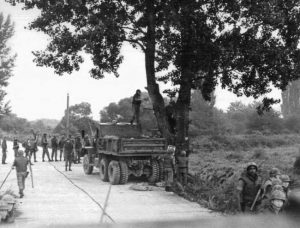 they parked their trucks near the Bridge of No Return, however, they started throwing out the sandbags that lined the truck bottoms, and handing out M16 rifles and M79 grenade launchers that had been concealed below. Several of the commandos also had M18 Claymore mines strapped to their chests with the firing mechanism in their hands, and were shouting at the North Koreans to cross the bridge. A U.S. Infantry company in 20 utility helicopters and seven Cobra attack helicopters circled behind them. Behind these helicopters, B-52 Stratofortresses, came from Guam escorted by US F-4 Phantom IIs from Kunsan Air Base and South Korean F-5 and F-86 fighters were visible flying across the sky at high altitude. At Taegu Air Base, F-111 bombers of the 366th Tactical Fighter Wing out of Mountain Home Air Force Base, were stationed, and F-4 Phantoms C and D from the 18th TFW Kadena Air Base and Clark Air Base were also deployed. The aircraft carrier USS Midway task force had also been moved to a station just offshore. Near the edges of the DMZ, many more heavily armed U.S. and South Korean infantry, artillery including the Second Battalion, 71st Air Defense Regiment armed with Improved Hawk missiles, and armor were waiting to back up the special operations team. Bases near the DMZ were prepared for demolition in case of a military response. The defense condition (DEFCON) was elevated on order of General Stilwell, as recounted in Colonel De LaTeur’s research paper later. 12,000 additional troops were ordered to Korea, including 1,800 Marines from Okinawa. During the operation, nuclear-capable strategic bombers circled over the JSA. According to an intelligence analyst monitoring the North Korea tactical radio net, the accumulation of force “blew their… minds.” Altogether, Task Force Vierra consisted of 813 men: almost all of the men of the United States Army Support Group, of which the Joint Security Force was a part; a South Korean reconnaissance company; a South Korean Special Forces company which had infiltrated the river area by the bridge the night before; and members of a reinforced composite rifle company from the 9th Infantry Regiment. In addition to this force, every UNC force in the rest of South Korea was on battle alert.
they parked their trucks near the Bridge of No Return, however, they started throwing out the sandbags that lined the truck bottoms, and handing out M16 rifles and M79 grenade launchers that had been concealed below. Several of the commandos also had M18 Claymore mines strapped to their chests with the firing mechanism in their hands, and were shouting at the North Koreans to cross the bridge. A U.S. Infantry company in 20 utility helicopters and seven Cobra attack helicopters circled behind them. Behind these helicopters, B-52 Stratofortresses, came from Guam escorted by US F-4 Phantom IIs from Kunsan Air Base and South Korean F-5 and F-86 fighters were visible flying across the sky at high altitude. At Taegu Air Base, F-111 bombers of the 366th Tactical Fighter Wing out of Mountain Home Air Force Base, were stationed, and F-4 Phantoms C and D from the 18th TFW Kadena Air Base and Clark Air Base were also deployed. The aircraft carrier USS Midway task force had also been moved to a station just offshore. Near the edges of the DMZ, many more heavily armed U.S. and South Korean infantry, artillery including the Second Battalion, 71st Air Defense Regiment armed with Improved Hawk missiles, and armor were waiting to back up the special operations team. Bases near the DMZ were prepared for demolition in case of a military response. The defense condition (DEFCON) was elevated on order of General Stilwell, as recounted in Colonel De LaTeur’s research paper later. 12,000 additional troops were ordered to Korea, including 1,800 Marines from Okinawa. During the operation, nuclear-capable strategic bombers circled over the JSA. According to an intelligence analyst monitoring the North Korea tactical radio net, the accumulation of force “blew their… minds.” Altogether, Task Force Vierra consisted of 813 men: almost all of the men of the United States Army Support Group, of which the Joint Security Force was a part; a South Korean reconnaissance company; a South Korean Special Forces company which had infiltrated the river area by the bridge the night before; and members of a reinforced composite rifle company from the 9th Infantry Regiment. In addition to this force, every UNC force in the rest of South Korea was on battle alert.

All this to cut down one tree!! My first thought on all this was…overkill, to the extreme!! That’s what I thought at first, but after researching the operation more, I realized that this was as much a show of force, as it was a way to cut down a tree that was really blocking a view that was necessary for keeping soldiers safe. North Korea needed to be shown what could come of such an attack, should it ever happen again. And it worked…North Korea accepted responsibility for the earlier killings. The incident is also known alternatively as the hatchet incident, the poplar tree incident, and the tree trimming incident. Final loss of life, two American Army officers, and one poplar tree.
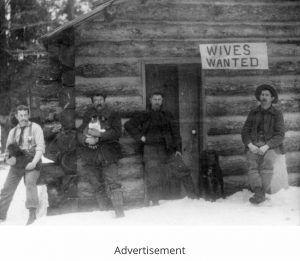 Most of us have either seen or heard of the television show called “The Bachelor.” The show is all about a single man in search of a bride. Of course, these days there are many ways to find the girl of his dreams, and most men would never go on television and let some reality show match him up with ten women for him to choose from. Of course, the idea of online dating sites is new and for some of us, still shocking too.
Most of us have either seen or heard of the television show called “The Bachelor.” The show is all about a single man in search of a bride. Of course, these days there are many ways to find the girl of his dreams, and most men would never go on television and let some reality show match him up with ten women for him to choose from. Of course, the idea of online dating sites is new and for some of us, still shocking too.
Many years ago, in the old west…especially during the gold rush days, the men in the west found themselves lonely…very lonely. They didn’t want to go back east, and few good women came to the west in those early days. Those were desperate times in the emotional lives of the gold rushers. The west was wild and unsettled, and even into the 1900s short on eligible women to marry.
There were no computers or smart phones then, and no dating apps or websites. So in an effort to find a wife, several eligible bachelors would stand in front of a log cabin, spiffed up as much as they could be, I suppose, many with beards, trying to let ok like a great catch. The photograph was then placed as an advertisement in papers back east. Personally, I don’t know if I would have been very inclined to jump on a train and head west to meet up with a man who was looking for a wife. Mail-order brides, sort of. These men would still have to woo the women, win them over, because these women weren’t slaves, and they weren’t required to stay. These bachelors would have to “sell” themselves and their lifestyle to these women, along with making the women fall in love with them.
I wondered, what kind of woman would answer such an ad. I don’t mean a loose woman, but likely a woman  who was a little bit past the normal marrying age of that time. An eighteen year old girl would never be the one to go. Her parents would likely never let her, but s woman who was in her mid-twenties would be viewed as a spinster, usually a school teacher, so she could take care of herself. She could tell her family that she was taking a job in the west. I’m sure they would be upset, but it would be her choice. And her family would have known it. Some women had no one, so there might be nothing to stop them. Still, going into the unknown like that would be scary. I don’t know how many of these men successfully found wives this way, but I suppose that if even a few did, it would be a successful bachelor show…of the time, anyway.
who was a little bit past the normal marrying age of that time. An eighteen year old girl would never be the one to go. Her parents would likely never let her, but s woman who was in her mid-twenties would be viewed as a spinster, usually a school teacher, so she could take care of herself. She could tell her family that she was taking a job in the west. I’m sure they would be upset, but it would be her choice. And her family would have known it. Some women had no one, so there might be nothing to stop them. Still, going into the unknown like that would be scary. I don’t know how many of these men successfully found wives this way, but I suppose that if even a few did, it would be a successful bachelor show…of the time, anyway.
 When the Apollo 11 crew landed on the moon, the world waited with unbridled excitement to view the moon rocks they were bringing back. It was an unprecedented event. Never before had man been able to look upon these space rocks. Soon, the astronauts would be treated to a ticker tape parades, and of course, the world tour to tell of their amazing escapades.
When the Apollo 11 crew landed on the moon, the world waited with unbridled excitement to view the moon rocks they were bringing back. It was an unprecedented event. Never before had man been able to look upon these space rocks. Soon, the astronauts would be treated to a ticker tape parades, and of course, the world tour to tell of their amazing escapades.
However, before all that, the astronauts had to do something that every world traveler understands…go through customs. What??? When I read that, I was stunned. Why would they need to go through customs? It’s not like they went shopping on the moon. Then again, they did bring back something they didn’t take with them…moon rocks, moon dust and other lunar samples, according to the customs form filed at the Honolulu Airport in Hawaii on July 24, 1969…the day the Apollo 11 screw splashed down in the Pacific Ocean to end their historic moon landing mission. Nevertheless, NASA had those almost immediately, didn’t they?
Apollo 11 astronauts Neil Armstrong, Buzz Aldrin and Michael Collins hd to declare the things they brought back, just like everyone else, and they had to declare not only their cargo, but also had to list their flight route as starting Cape Kennedy (now Cape Canaveral) in Florida with a stopover on the moon. Then all three men had to sign the form, so everything was legal.
The form was posted to the U.S. Customs and Border Protection Web site in 2009, to mark the Apollo 11 mission’s 40th anniversary. A copy was obtained by SPACE.com and verified by NASA. John Yembrick told SPACE.com that it was indeed authentic, was a little joke at that time, and maybe it was, but the reality is that not much has changed over the years. The big joke was the fact that because Apollo 11 splashed down 920 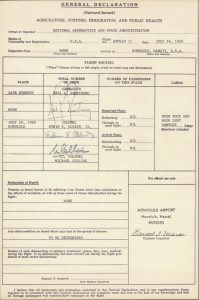 miles southwest of Hawaii and 13 miles from the USS Hornet, the Navy ship sent to recover the crew. It took two more days for the astronauts to actually return to Hawaii on July 26, where they were welcomed with a July 27 ceremony at Pearl Harbor. So customs was a bit delayed.
miles southwest of Hawaii and 13 miles from the USS Hornet, the Navy ship sent to recover the crew. It took two more days for the astronauts to actually return to Hawaii on July 26, where they were welcomed with a July 27 ceremony at Pearl Harbor. So customs was a bit delayed.
Still, the astronauts were trapped inside a NASA trailer as part of a quarantine effort. The concern was the possibility of germs they might have picked up. They had to wear special biological containment suits when they walked out on the deck of the USS Hornet after being retrieved. Then, NASA transported them to Houston, quarantine trailer and all, and they emerged from isolation three weeks later. Today’s returning astronauts exit their spacecraft almost immediately. Some, who have been in space a long time receive medical checks after spending months in the weightlessness of space. Nevertheless, today’s NASA astronauts still have to go through customs, and I still find that quite funny.

